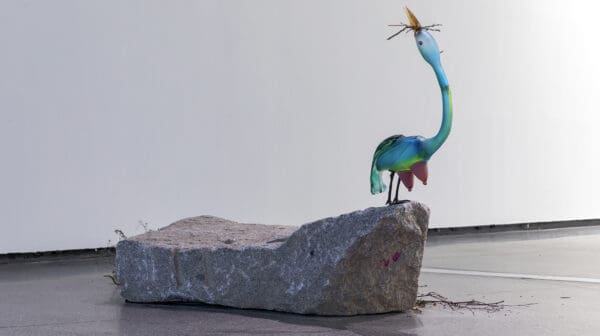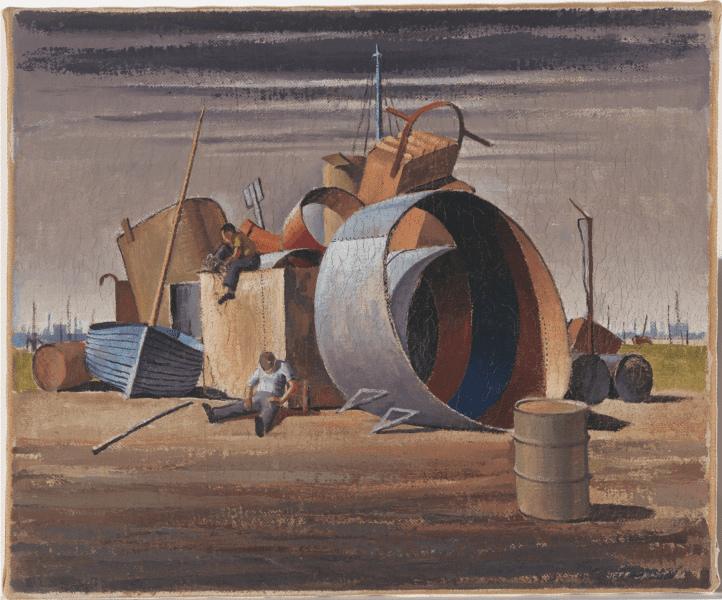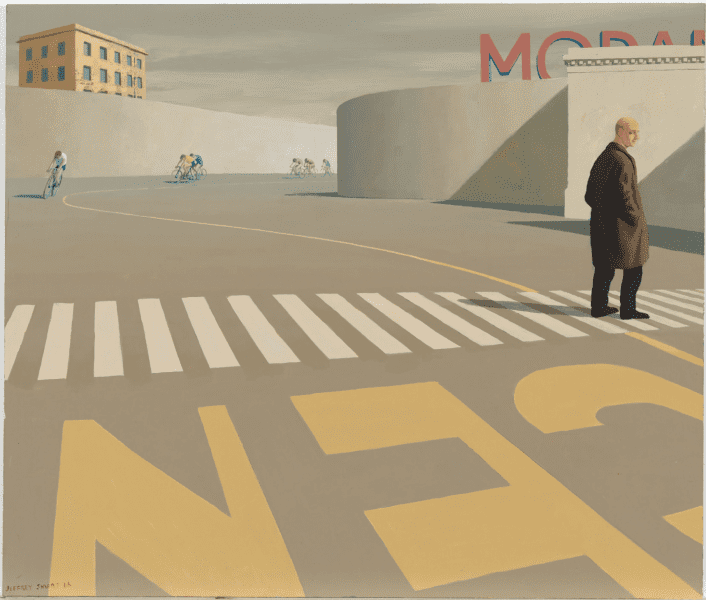
Laure Prouvost meets the real with the ludicrous
French-born/Belgium-based Laure Prouvost animates her first major Australian survey with her hallmark absurdism. ‘Oui Move In You’ is showing now at the Australian Centre for Contemporary Art.
Jeffrey Smart’s paintings are distinctive. Sparsely populated, some of his near-empty metropolitan scenes have a melancholic, almost cataclysmic, air—like prescient glimpses of cities in lockdown—while others seem infused with an irreverent and sophisticated sense of play.
Born in Adelaide in 1921, Smart left Australia permanently in 1963 for Italy, where he resided until his death in 2013. Nevertheless, the artist continues to exert a powerful influence in the country of his birth. He was a dedicated correspondent and kept in touch with many Australian artists and curators via letter and fax, as well as by phone and frequent visits. And of course through his work, which continues to shape how we see the city.
With a large-scale retrospective of Jeffrey Smart’s work, opening at the National Gallery of Australia, we have asked artists Rick Amor, Joanna Lamb, Christopher Pease and Erin Coates, and curator Barry Pearce, to each comment on one of Smart’s paintings. Some, like Pearce and Amor, knew him well, but they all have felt the pull of Smart’s extraordinary vision.

Rick Amor: The salvagers foreshadows Jeffrey Smart’s later works. The lowering sky, industrial setting, and careful composition appeared throughout his career.
In 2001, at about three in the morning, we woke to the clattering of the fax machine. The message came from Jeffrey, a man I had never met. He had seen my work reproduced and tracked down my number. We began a correspondence by fax covering technical painting matters and art world gossip, which he loved. Jeffrey attended performances of Wagner’s Ring Cycle all around the world and needed house-sitters to mind his gaggle of un-house-trained pugs each time he left Italy. In 2003 he asked us to mind the house while he and his partner Ermes came to Australia for a performance in Adelaide. Before we left he phoned asking how we would be travelling: “Not cattle class I hope.” I said we were. “Oh, you’ll bring shame on the house!” We upgraded to business class.
A number of critics have assumed that Jeffrey Smart and I share similar preoccupations. I disagree. He was always in the present, while I deal in personal nostalgia. I always found him generous, intelligent and very funny.

Joanna Lamb: Formal aspects of arranging colour and shape are intrinsic to the success of Smart’s compositions. He often said that his figures were used to provide a sense of scale more than to influence any narrative element. Yet in 1989, I saw this painting for the first time on the cover of Helen Daniel’s book Expressway. She invited 29 Australian writers to use narrative to interpret its surreal ambiguity. It has remained vivid in my mind ever since.
The work has a timeless quality. It is a modernised urban environment painted using a stripped back, stylised realism. This emptiness and the dramatic lighting give a dystopian feel to the landscape. It is imbued with a dreamlike quality, and speaks to a psychological state of isolation as a general human condition. It could quite easily be a premonition of our current times.
There are definite links between my earlier work especially, and that of Jeffrey Smart. I’ve always found everyday scenes of concrete highways, streetscapes and apartment buildings interesting. Cahill Expressway informed many of my works over a period of several years. It is something of note that a single work could have such an influence on me as an artist.

Christopher Pease: This work was an homage to Giorgio Morandi, an Italian artist who predominantly painted still-lifes with subtle tones and simplified forms. Morandi died two years before The bicycle race was painted, and he was most likely an influence on Smart’s developing style. In this painting the urban landscape is treated like a still life; the figures are the fruit that provide a subtle narrative. There is movement and stillness at the same time, forming a strange dreamlike atmosphere.
My work Nyoongar Dreaming, from my first solo show in 1999, was directly influenced by Smart’s work. He often painted streets with arrows, lines and traffic cones and this imagery was always sitting in the back of my mind. One morning, while driving my wife to work, I came across an intersection that led onto the newly formed Graham Farmer Freeway [in Perth]. I went back the next morning. It was closed to traffic, and was still under construction, so I walked around and took photos. It was like being in a Jeffrey Smart painting with its incomplete traffic lights and signage and it formed the basis for the work. The lone figure, Peter Farmer (Graham’s nephew), was added later.

Erin Coates: I love the combination of absurdist architecture—a pink spiral staircase to literally nowhere—with the utter mundanity of the descending figure, who appears to be a balding businessman. For me this painting exemplifies a particular atmosphere Jeffrey Smart could bring to his paintings. He was able to create delightful urban follies with an edge of something darker, almost dystopic. Perhaps most interesting is that he allows his figures to just go about their day, without drama, strolling through an off-kilter precinct of the city. This has always piqued my curiosity.
Several years ago I made videos of an extended series of urban interventions in which my rock climber friends and I climbed public artworks and architecture; remapping the built environment through covert kinespheric interactions. At this time I remember really enjoying Smart’s paintings. His figures are never overwhelmed by architecture and are at ease with the strangeness of what surrounds them. This resonated with me. I was trying to understand other potential ways to interact with urban environments, and how this changes notions of power, community and ownership. In a playful and often cryptic way, I think Jeffrey Smart was also trying to propose different possibilities for how we inhabit the city.

Barry Pearce: Over three decades of friendship with Jeffrey, I would count many more than a few as favourites. But none as deeply intriguing as his very last, Labyrinth.
With nearly each of his compositions the source is quotidian: an anonymous factory edifice, a block of flats, road signs, a truck, a freeway overpass, graffiti-covered walls and fences, but above all a certain fall of light and its unexpected poetic revelation. Labyrinth is quite different. He never saw such a structure in the flesh.
My revelation about the painting came shortly before Jeffrey’s passing in Tuscany in 2013. When I visited him at the end of 2012 he was close to being permanently immobilised with illness, no longer able to enter the studio, and wanted to reflect mainly on Adelaide, where his odyssey had begun. It then dawned on me that Labyrinth may have reminded him of the amazing back lanes and alleyways of that city, and crisp celestial light, that were so magical for him as a child; contributing profoundly to the shaping of his quest for a stillness at the centre of a spinning planet.
With a sardonic smile he murmured, “Sorry, faux-Sherlock, you may be getting just a bit too close to a secret.” He fell asleep and we left it at that.
Jeffrey Smart
National Gallery of Australia
11 December 2021 – 15 May 2022
This article was originally published in the September/October 2021 print edition of Art Guide Australia.